Art World
To Celebrate Easter, Here Are 10 Art-Historical Easter Eggs Hidden Inside Famous Works of Art
From Giotto to Edward Steichen, here are some clever art secrets that are worth the hunt.
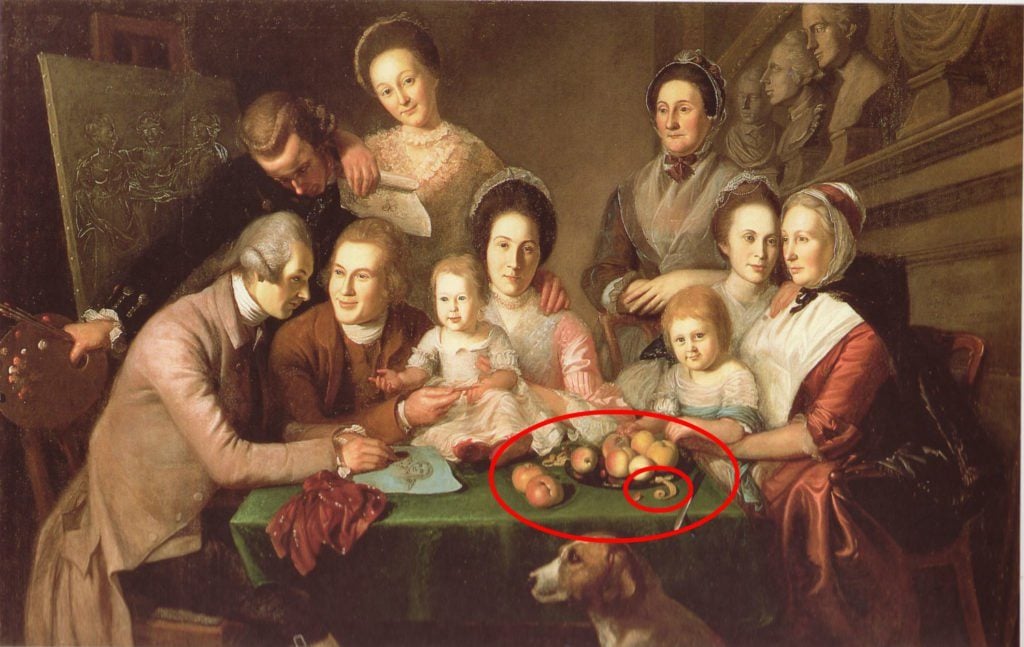
From Giotto to Edward Steichen, here are some clever art secrets that are worth the hunt.

Easter is upon us, and even now, parents are plotting where to stash their colored eggs and egg-shaped chocolate objects throughout their houses. Of course, in contemporary parlance, the term “Easter Egg” has also come to mean any hidden reference stashed in a work of art. So, for the occasion, artnet News had our staff pick a few of their favorite secrets hidden away in art history’s greats. Enjoy!
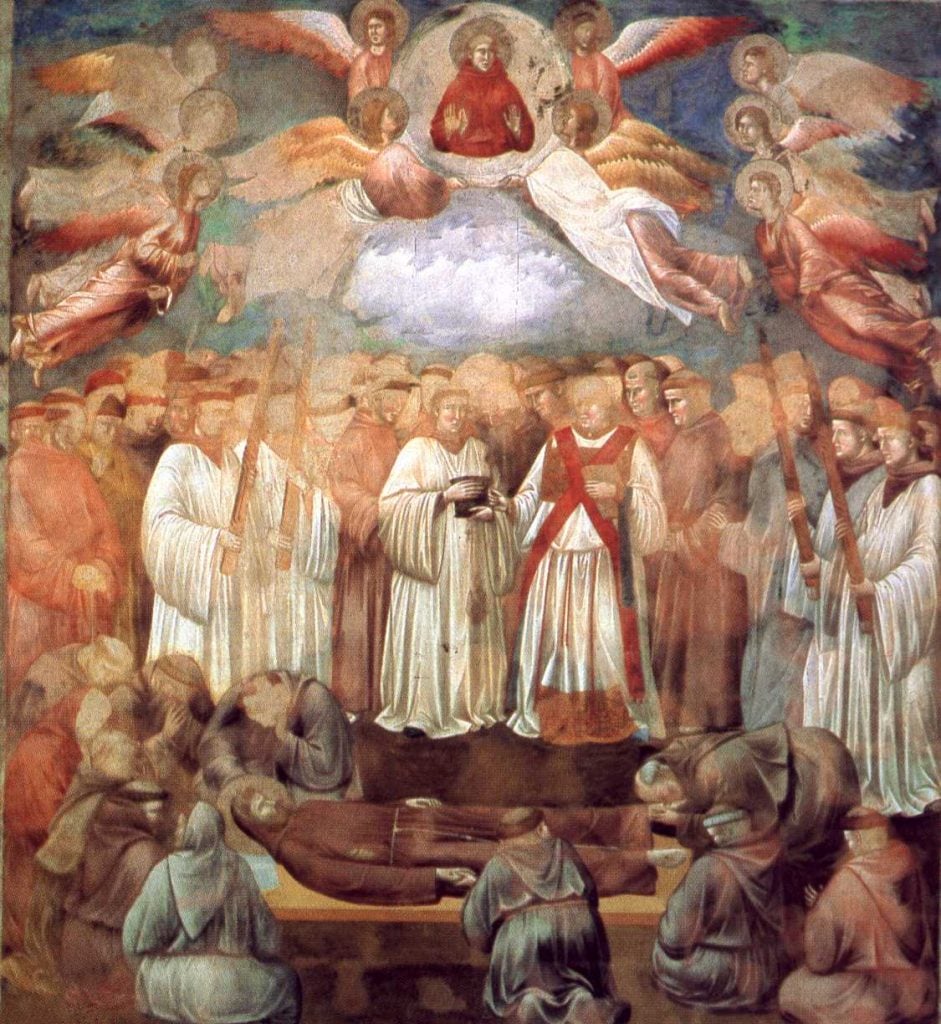
Giotto, Death and Ascension of St. Francis (1300). Basilica of Saint Francis of Assisi, Assisi, Italy.
One panel of a famous cycle by the Renaissance founder Giotto in the upper church of the Basilica of Saint Francis in Assisi, Italy, the Death and Ascension of St Francis depicts its subject being laid to rest and carried to heaven. In 2011, however, medievalist Chiara Frugoni discovered a heretofore unnoticed hidden image lurking within the cloud of smoke between heaven and earth: “a powerful portrait, with a hooked nose, sunken eyes and two dark horns,” i.e. the devil.
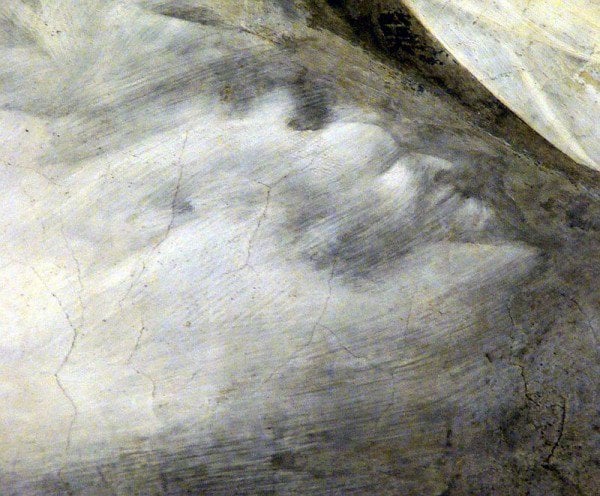
Giotto, Death and Ascension of St. Francis (1300), detail. Basilica of Saint Francis of Assisi, Assisi, Italy.
What does it mean? The basilica’s chief restorer told Reuters that he thought Giotto added the hidden detail “to have a bit of fun.”
—Ben Davis
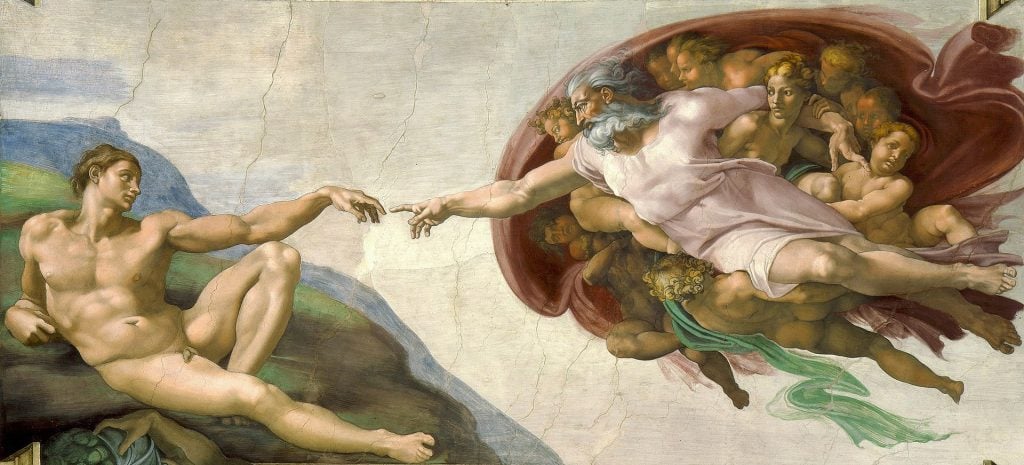
Michelangelo Buonarroti, The Creation of Adam in the Sistine Chapel at the Vatican Museums, Rome.
Art historians have been studying Michelangelo’s Sistine Chapel for hundreds of years, but it is doctors who’ve had some of the more surprising discoveries about the masterpiece in recent decades. In 1990, physician Frank Meshberger pointed out that in the panel The Creation of Adam, the region defined by the swooping cloak around God the Father resembles an anatomically correct cutaway of the human skull (the theory recently surfaced once again on the HBO show Westworld). Meshberger theorized that it was Michelangelo’s way of showing how God gave Adam both the gift of human life and of human intelligence.
Neurosurgery researchers at Johns Hopkins University also later came to believe that Michelangelo depicted a brain stem and spinal cord along the throat of God in the panel The Separation of Light from Darkness. The throat had long appeared anatomically incorrect to art historians, lending some credence to the researchers’ otherwise outlandish-seeming position. Regardless of Michelangelo’s intent, we know he was an avid student of human anatomy, and other experts in neuroanatomy say they detect elements of their own training in his work (oh, and they’ve made graphics). The researchers told NPR that they showed an image of the work to some of their colleagues “and without saying much, they spontaneously recognized the brainstem.”
—Rachel Corbett

Albrecht Dürer, Melancholia I (1514).
The enigmatic and iconic Melancholia doesn’t just have an Easter Egg, but a whole basket of Easter Eggs. Let us focus, however, on the aspect of it that is quite literally the most puzzling: the “magic square” at the top right. The number grid’s significance is this: It yields the same number, 34, if you add up any of its columns, rows, or four quadrants.
What’s the meaning of the figure? Such perfect mathematical balance made it a symbol of the divine, on the one hand, and since the subject of Melancholia is the link between melancholy and genius, perhaps also a sign of thinking too much. And yet, in fact, the opposite has been suggested: This particular four-by-four “magic square” is known as the “Square of Jupiter,” and associated with that planet. Since everything else in Dürer’s print is associated with Saturn and the saturnine temperament, whose influence Jupiter was thought to counteract, the square might in fact stand as a kind of healing talisman here.

Dürer’s Square of Jupiter.
Then again, there might be another reason the German Renaissance master used this particular permutation of the square: The two spaces in the center of its bottom-most row are 15 and 14, and 1514 also happens to be the year Melancholia I was made.
—Ben Davis
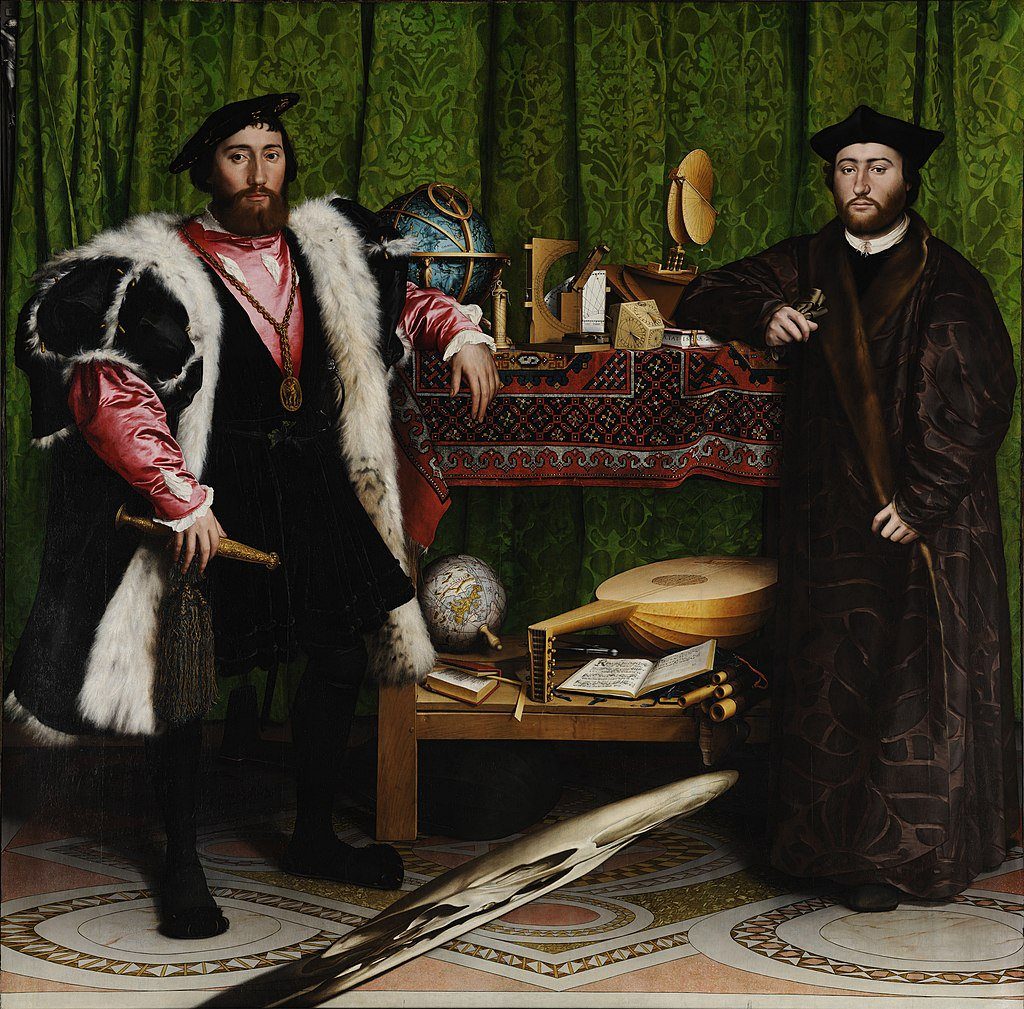
Hans Holbein the Younger, The Ambassadors (1533). Collection of the National Gallery, London.
Holbein’s masterpiece likely stands as one of the most famous Easter Eggs in all of art history. Although the painting’s ostensible subjects are the two titular French diplomats, ambassador to England Jean de Dinteville and half-bishop/half-ambassador Georges de Selve, the painter gives the foreground over to the one figure we all answer to eventually.
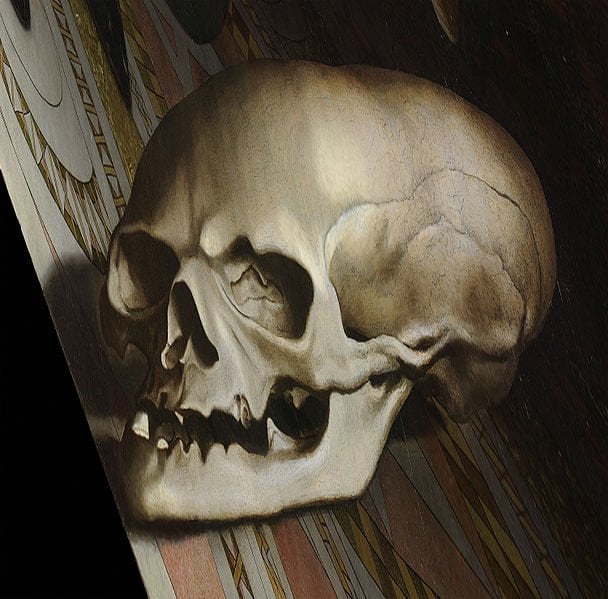
Hans Holbein the Younger, The Ambassadors (1533), detail with
Holbein’s anamorphotic object seen at an angle. Collection of the National Gallery, London.
The center-bottom of the work harbors what at first appears to be an abstract smear of black and yellowish-gray. When viewed at an oblique angle from the right side of the painting, the skewed shape “corrects” to reveal an imposing skull—possibly Holbein’s reminder that death lies in wait even when it can be temporarily hidden by youth, earthly riches, and influence.
—Tim Schneider
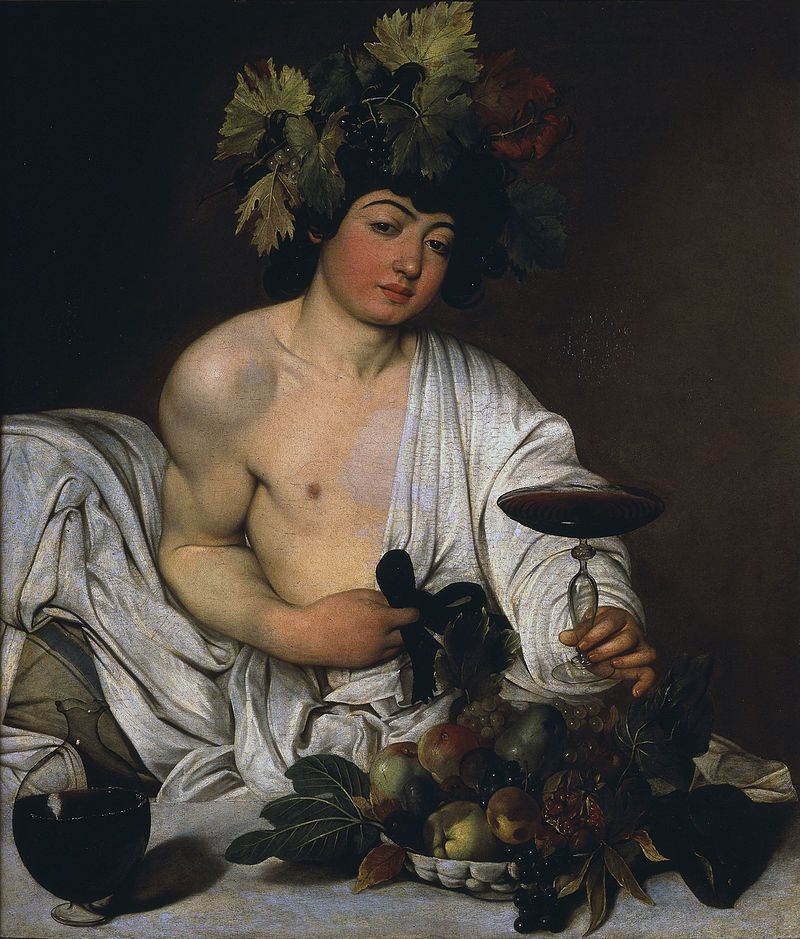
Caravaggio, Bacchus (ca. 1595). Collection of the Uffizi, Florence.
It might be enough for the average hedonistic artist to just paint their visage onto the god of wine and fertility and call it a day. But Caravaggio was as extraordinary a hedonist as he was a painter. As covered in Stephen Akey’s “Thug: A Life of Caravaggio in 69 Paragraphs,” the man wasn’t just sleeping with most of his models; he may have been pimping them. He wasn’t just drinking to excess; he was getting hospitalized. And he wasn’t just threatening to duel people; he legit killed a guy. Maybe that full-throttle temperament is why Caravaggio couldn’t resist throwing a tiny portrait of himself at the easel inside Bacchus’s carafe—a nugget of art historical mischief rediscovered in 2009 through advanced imaging devices.
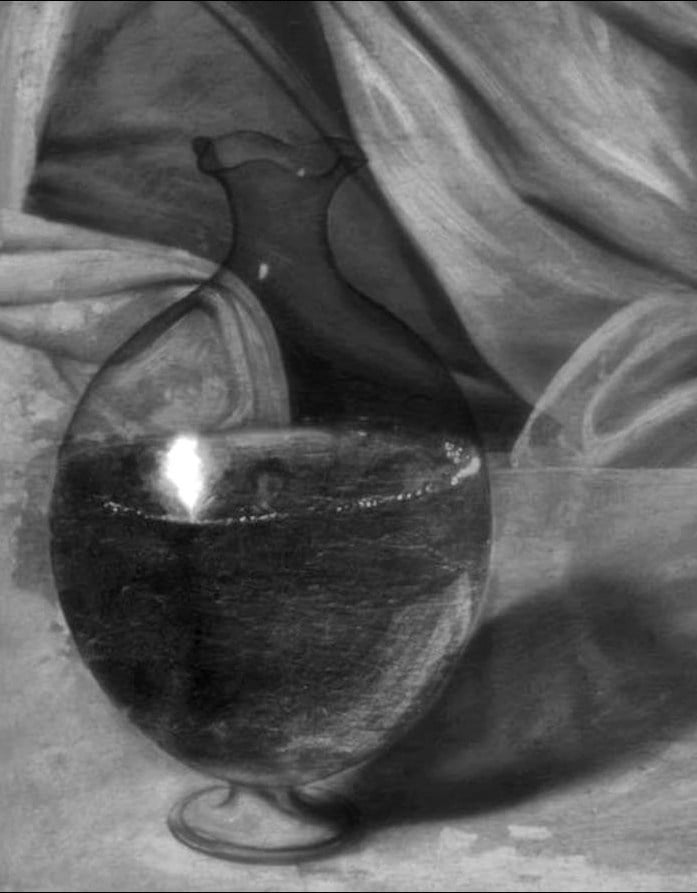
Infrared detail of Bacchus with Caravaggio’s hidden self-portrait.
As always with my favorite Old Master and ne’er-do-well, if it was worth doing, it was worth overdoing.
—Tim Schneider
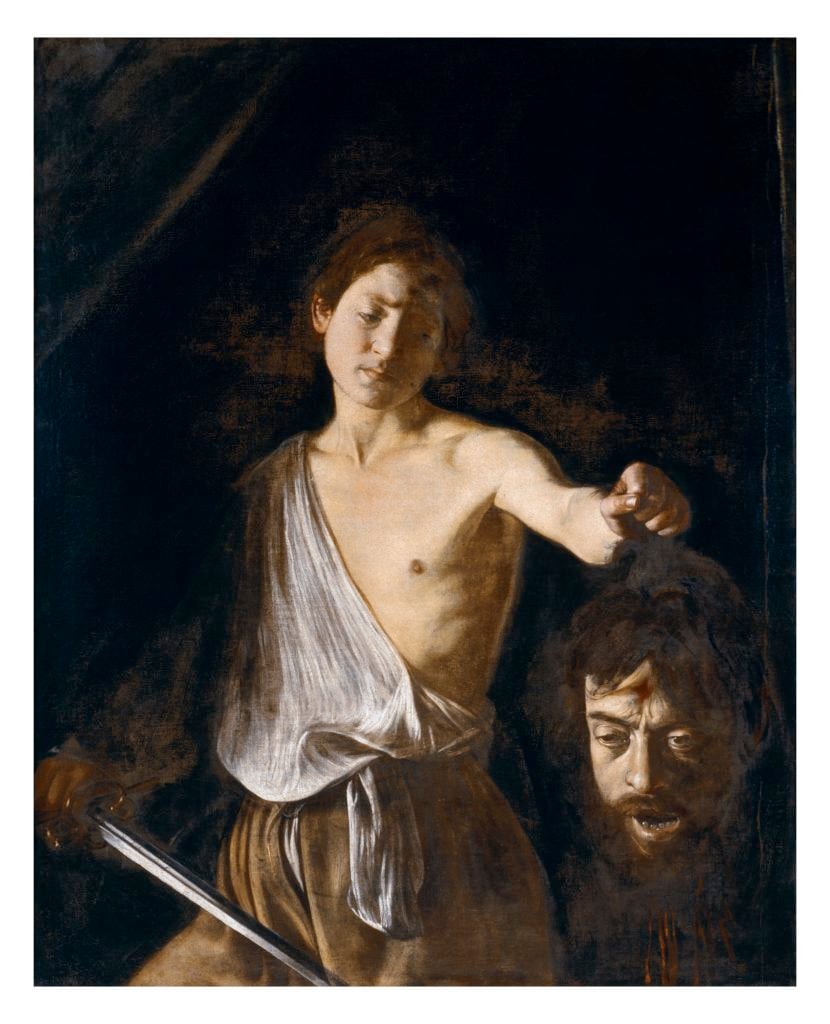
Caravaggio, David with The Head of Goliath, (1610). Courtesy of the Ministry of Cultural Heritage and Activities and Tourism, collection of the Galleria Borghese, Rome.
Flash forward to the final year of Caravaggio’s life. Unlike many of his contemporaries, who often embedded glorified versions of themselves in their paintings, the Baroque master took an unusually introspective approach in his depiction of David With the Head of Goliath: He painted his own likeness as the severed head.
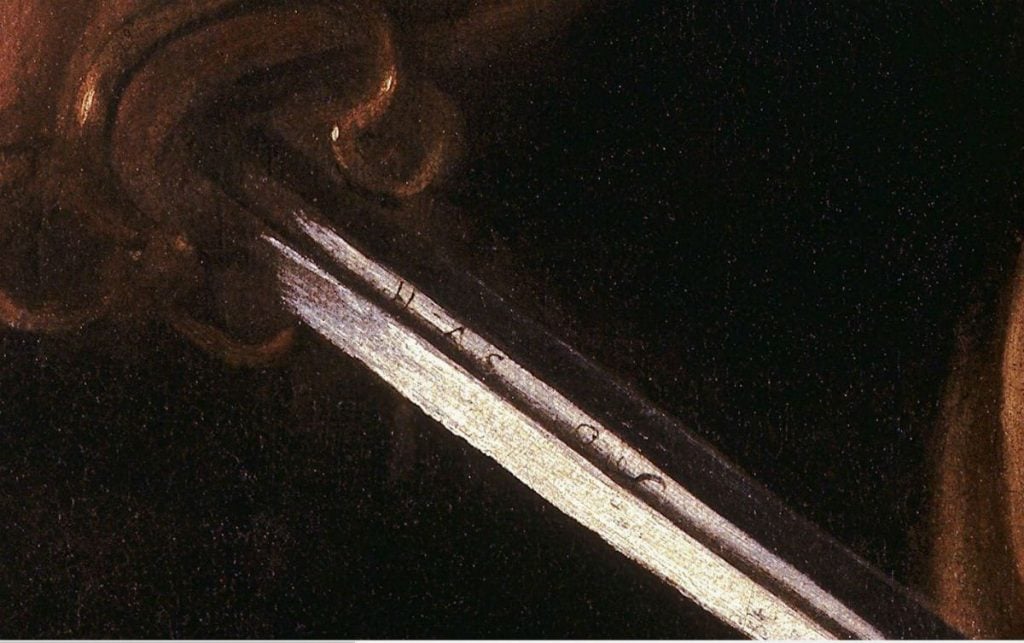
Caravaggio, David with The Head of Goliath, (1610), detail of the sword. Courtesy of the Ministry of Cultural Heritage and Activities and Tourism, collection of the Galleria Borghese, Rome.
Going even further, some art historians have suggested that the letters encrypted on David’s sword ‘H—AS O.S.’ stand for the Latin humilitas occidit superbiam (humility kills pride). By representing himself as the embodiment of the evil Goliath, Caravaggio acknowledges the murder of the Maltese knight Ranuccio Tomassoni in a street brawl in Rome in 1606 and, right at the wire, repents for his sin and failure as a Christian.
—Henri Neuendorf
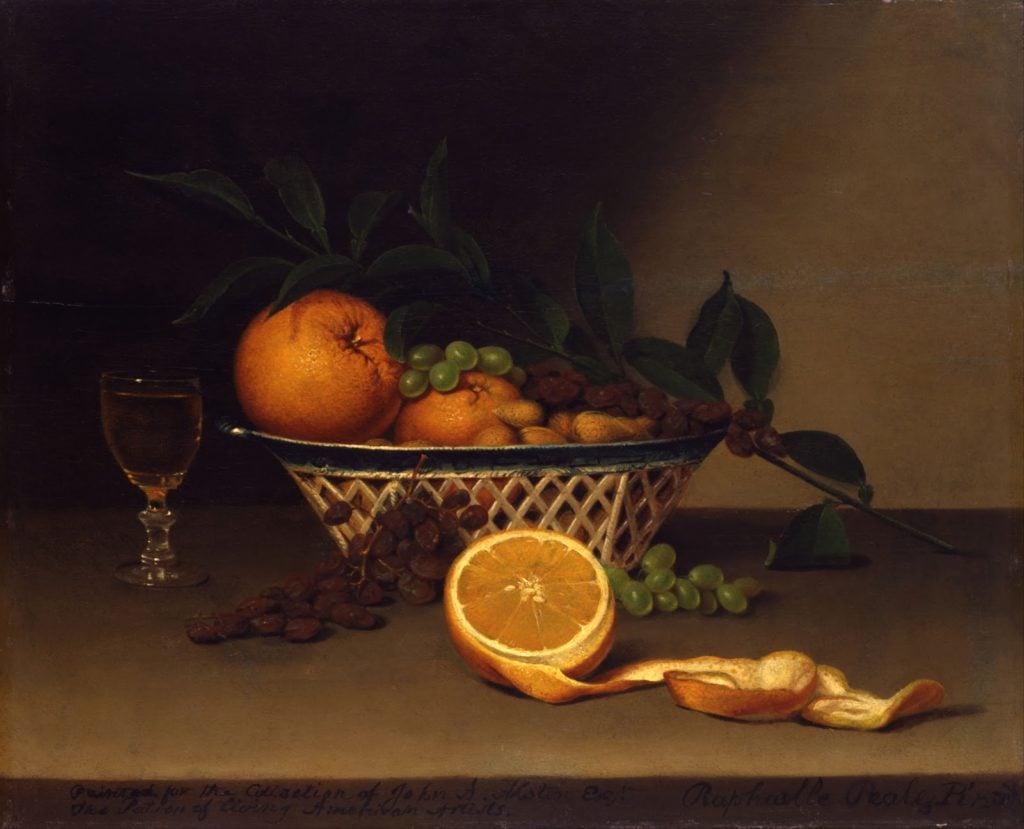
Raphaelle Peale, Still Life With Oranges (c. 1818). Photo courtesy of the Toledo Museum of Art.
The oldest surviving son of pioneering colonial painter Charles Willson Peale, Raphelle Peale’s career as an artist was practically predestined, as his father named nine of his 17 children after Old Masters. In what was perhaps a bit of a running joke within the family, the Peales would sometimes include a curling fruit peel in their works to serve as a figurative signature and obvious pun on their last name. Thus, there’s an apple peel on the table in Charles’s The Peale Family, the ambitious family portrait he painted between 1773 and 1809 as an advertisement of his skill as a portraitist.
When Raphaelle struggled to attract clients of his own, he turned to still lifes, which could appeal to a broader audience than any one specific patron. So if you’re wandering through the American wing at any given museum, keep an eye on the still-life paintings—if there’s an elegantly peeled orange, that’s just Raphelle Peale, signing his name a second time.
—Sarah Cascone

Vincent van Gogh, Café Terrace at Night (1888). Collection of tthe Kröller-Müller Museum, Otterlo, Netherlands.
Maybe this one seems a bit of a stretch, but since it’s very related to Easter (and Passover), bear with me. There is a theory floating around out there that Van Gogh’s painting of a nighttime café is, in fact, a coded reference to the Last Supper. Think about it: There are 12 customers under that charming awning, and, in the middle, a central figure. Some might dismiss the white-clad individual as a waitress, but researcher Jared Baxter maintains the figure is meant to represent Jesus.
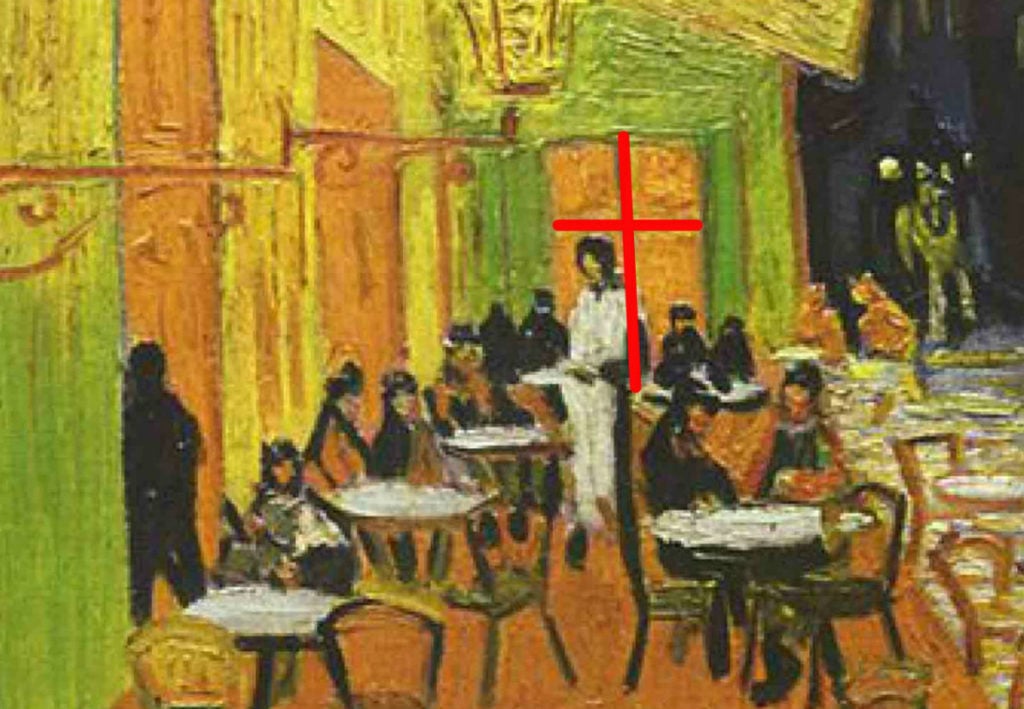
Detail of the cafe, with possible cross emphasized.
As supporting evidence, he cites the cross-like forms in the windows behind and a letter the artist wrote his brother Theo around the time he completed the painting. In it, Van Gogh says he feels a “tremendous need for, shall I say the word—for religion.”
—Julia Halperin
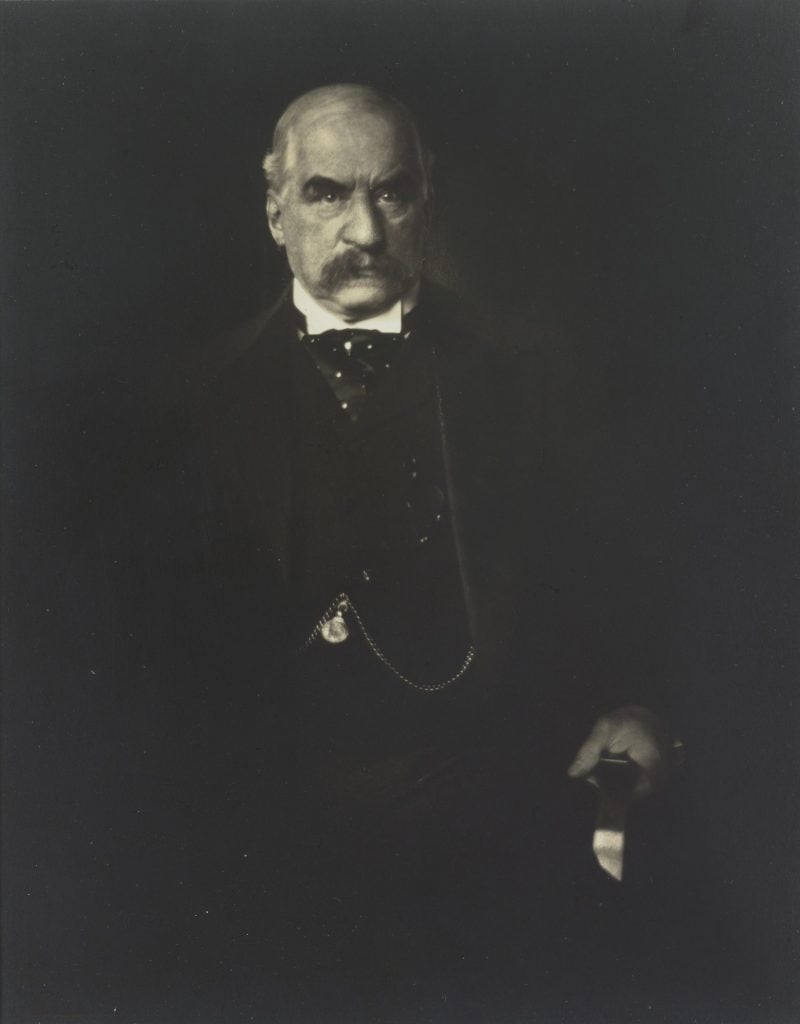
Edward Steichen, J.P Morgan (1903).
The stunningly fierce portrait of robber baron J.P. Morgan more or less made Edward Steichen’s storied career. It is the product of a session that lasted exactly three minutes, during which he got two shots, the first, more relaxed that became the basis of a painted portrait, and the second which defined Morgan’s image as a hard-driving capitalist. The detail that seizes the imagination, however, is the way that Steichen captured his hand gripping the handle of the chair he is in, which produces the optical illusion that Morgan is brandishing a dagger pointed out at the viewer. Steichen claimed the detail wasn’t intentional. It is hard to forget once you have seen it.
—Ben Davis
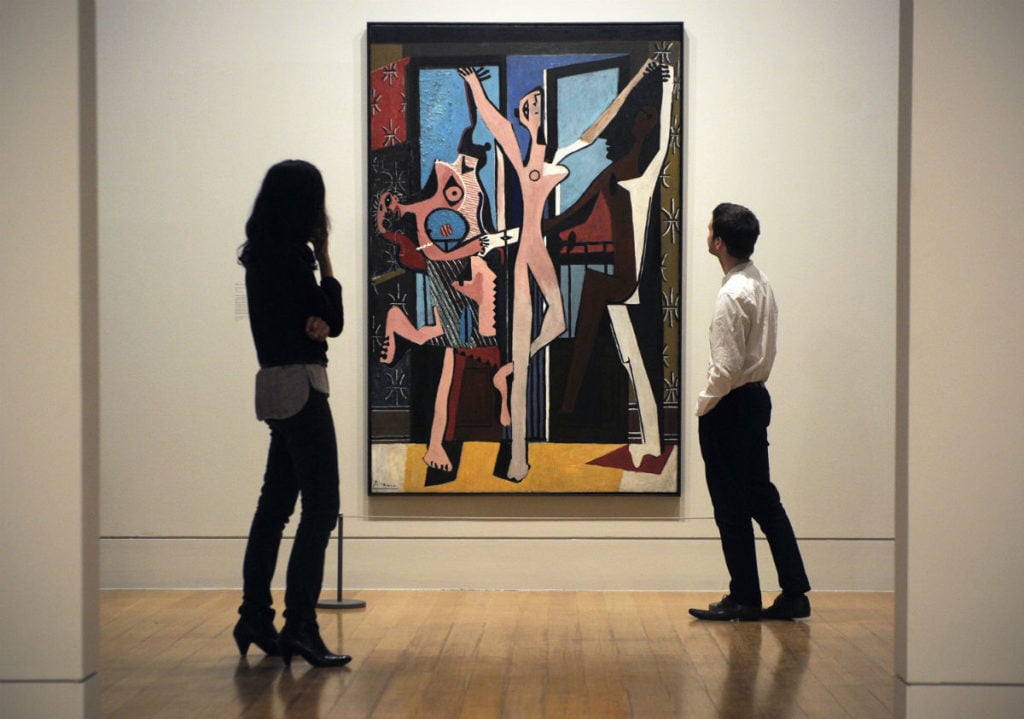
Pablo Picasso’s The Three Dancers (1925) at the Tate gallery, February 13, 2012. Photo courtesy Carl Court /AFP/Getty Images.
If you go down to Tate Modern’s “Picasso 1932: Love, Fame, Tragedy” this Easter, look closely at the artist’s great painting The Three Dancers of 1925. Some think Picasso included a self-portrait in the painting, making an Alfred Hitchcock-like appearance in the background. Check out the face to the right of the outstretched right arm of the central dancer.
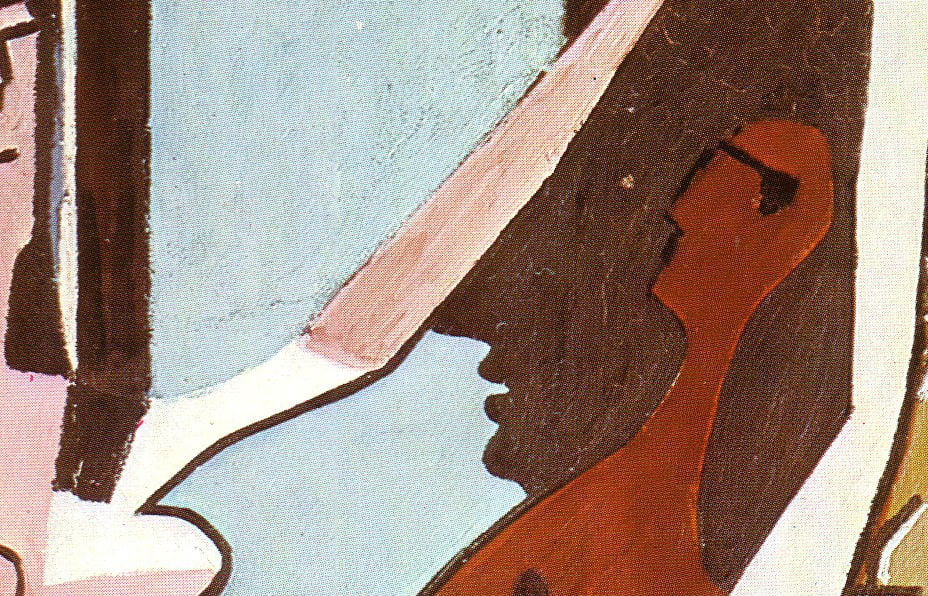
Detail of Picasso’s The Three Dancers, featuring the disputed silhouette. Image courtesy NichoDesign on Flickr.
Picasso maintained that the silhouette was his friend, the artist Ramon Pichot, who committed suicide in 1925. In fact, he told Roland Penrose, who persuaded a reluctant Picasso to sell the painting to the Tate in 1965, that the work should be called The Death of Pichot rather than The Three Dancers.
—Javier Pes